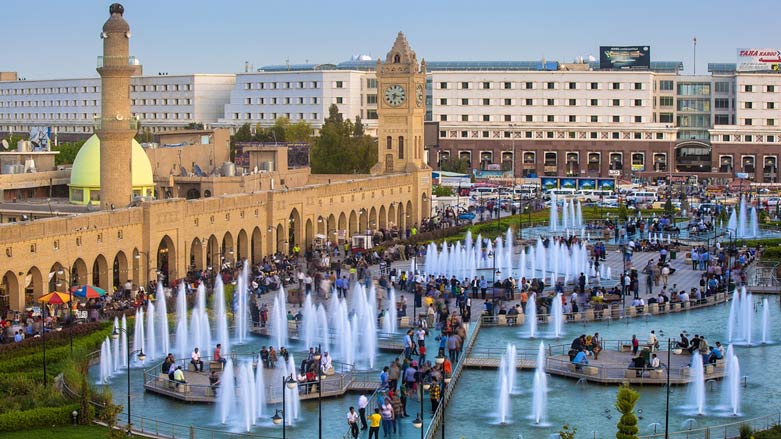Erbil: Walking Tour of the Cultural History of the Lower City

Erbil is renowned for its tall, fortified citadel said to be among the oldest continuously inhabited settlements in the world, if not the most. But just below the famous citadel is the lower city of Erbil, which ebbed and flowed as prosperity allowed and today is the chaotic accumulation of many centuries of cyclical depopulation and urbanization.

Chaixanay Machiko is an easy place to begin your journey. Founded in 1940 by Majid “Machiko” Ismael, at the time it was the only tea shop outside the citadel. Today, his son and grandson manage the tea shop, which is the oldest in all Erbil and has become a local landmark.

Directly above Chaixanay Machiko is the citadel’s southern gate. For most of the Citadel's history, it was the only point of entry and is the lowest point on the mound. It was completely rebuilt in in 1860 by master mason Ismail al-Sinini but was totally destroyed in 1960. Under the Baath regime, a new gate in a generic Arab style was built in 1979, which, according to local tradition, is distinct from the Kurdish style by the use of rounded rather than pointed archways. When the Citadel came under UNESCO regulations, the decision was made to demolish the historically inaccurate gate of the 1970s and replace it with a meticulous reconstruction of the 19th-century original. The reconstruction was recently completed.

Across the street is the bazaar, a fascinating symbol of three eras of rapid urbanization in Erbil. The most recent is the easiest to see: the newly built arcade and corridors done in an archaizing style with yellow bricks, to entice shoppers and tourists with a folkloric setting.

But just behind the yellow brickwork are buildings of the late 20th century whose upper floors can be seen rising above the bazaar. They are a unique feature of Erbil with scaled-down hints of Brutalism due to the practice of educating Iraqi architects and engineers in the Soviet Union under the Baath regime.

At the core of this cobweb of eras are two original old qaysari market buildings that date to the late 19th and early 20th centuries, which was the timeframe of the first wave of urbanization in modern Erbil.




Exiting the bazaar, look above to study the citadel walls.

The buttressing at the base of the walls harkens back to when the perimeter had to be reinforced against invading hordes seeking to break in and loot the citadel.

However, by the late Ottoman era, this particular threat had subsided, and so houses subsumed the original fortress architecture.

Across from the citadel and the governorate building is the unassuming, tucked-away shrine of Gokbori, or Sultan Muzaffar as he is locally known in Kurdish and Arabic.

One of the 12th century’s most compelling military leaders, he was born into a Turkoman family in 1154 and fought alongside Salahaddin to overthrow the Crusaders in Jerusalem. He retired to Erbil where he set to work developing the city far beyond the confines of the citadel.


At its height under his rule, the city extended all the way to the mosque which he built down the road, of which only the minaret remains today. One of his direct legacies is the grand annual celebration of the Prophet Mohamed’s birthday, Mawlid, in Erbil which he honored in such a fantastic way that it became uniquely ingrained in the city's culture to this day. His shrine is most busy during Mawlid.

Down the road from the shrine of Gokbori, there is a minaret associated with him. It was originally built together with a mosque, but only the ruin of the minaret remains some eight centuries later, and the mosque is completely gone. The intricacy of its decoration and its enormous size speaks to the ambition and dedication of his rule. Another testimony to his greatness is that Erbil’s fortunes largely rescinded in later centuries, to such a degree that the city completely withdrew to its nucleus in and around the citadel, and the minaret became known locally as the Minaray Choly or the "minaret of the hinterland."

Across the street from the minaret is the shrine of the Prophet Ezra, a Jewish prophet whose history is preserved in the Book of Ezra and Nechemia in the Old Testament, and who is known as Uzair in the Quran. The interior includes a tiny cemetery built next to the shrine itself, which is tended to by an elderly woman who happily welcomes pilgrims.

Continuing along into the lower city is an overwhelming labyrinth of traditional homes, recent development, and tucked-away sites of worship and local pilgrimage. There are three main neighborhoods: the Khanaqa neighborhood, which was the center of the Sufi community; the Arab quarter, so named because of the many Arab families who lived there in the 20th century; and Taajeel, a historic Turkoman neighborhood which thrives to this day.





All three of these neighborhoods have gained new and apocryphal legends about being inhabited entirely (then inhabited) by Jews. The truth is that many of the old houses are vacant because of the local Muslim majority relocating in the 21st century to more comfortable homes, by their own volition or through government initiatives. Physical evidence of the Jews in Erbil was unfortunately largely obscured or totally lost following their expulsion in the 20th century.



Traditional grave markers had carvings of canes, swords, guns, and other symbols of the deceased and were possibly a useful means of identifying the right grave in a broadly illiterate society.

Penj Ali is said to have lived seven centuries ago. His name translates as “Five Ali, ” and the caretaker of his shrine says two beliefs surround this nickname: either he was one five siblings all named Ali, or that he was named Five Ali after the divine strength of the five fingers of each hand. There is a grooved rock which is said to have gotten its shape by the sheer force of his grip.

When you arrive back at Chaixanay Machiko, make sure to stop at the Museum of Education down the road. Housed in the building that was the first modern schoolhouse in Erbil, it today has a collection of photos, antiques, documents, and miscellany.

At this quiet little museum, you can find a moment of solitude and reflection. Erbil is an overwhelming city at the nexus of antiquity and modernity. History stretching back to ancient Mesopotamia can be found at archaeological sites such as the citadel, Qalinch Agha, Kilik Mishik, and Qasra, but the modern metropolis has grown, and now high-rise towers loom over the horizon as well.
Editing by G.H. Renaud
